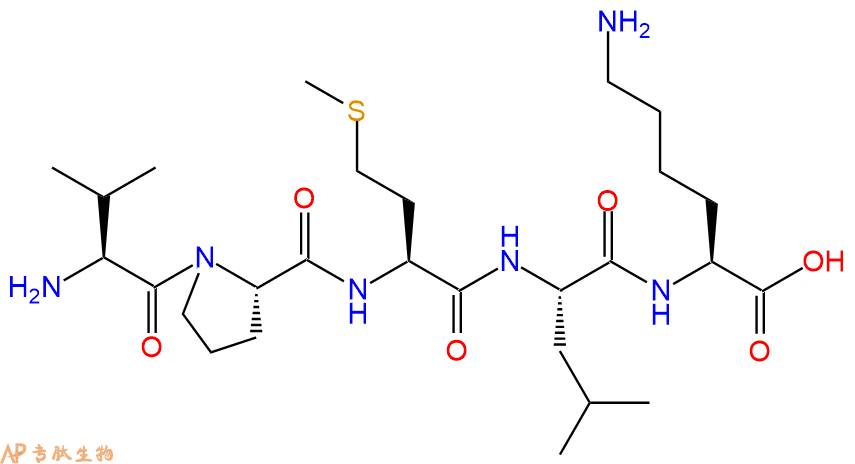400-998-5282
专注多肽 服务科研
400-998-5282
专注多肽 服务科研

Bax抑制剂肽V5醋酸盐是Bax介导的细胞凋亡抑制剂,是Bcl-2家族蛋白的促凋亡成员,在线粒体依赖性细胞凋亡中发挥重要作用。用于癌症治疗。
编号:429548
CAS号:579492-81-2/2760881-58-9
单字母:H2N-VPMLK-OH
| 编号: | 429548 |
| 中文名称: | Bax抑制剂多肽 Bax inhibitor peptide V5 |
| 英文名: | Bax inhibitor peptide V5 |
| CAS号: | 579492-81-2,free base 2760881-58-9,醋酸盐 |
| 单字母: | H2N-VPMLK-OH |
| 三字母: | H2N N端氨基:N-terminal amino group。在肽或多肽链中含有游离a-氨基的氨基酸一端。在表示氨基酸序列时,通常将N端放在肽链的左边。 -ValL-缬氨酸:valine。系统命名为(2S)-氨基-3-甲基丁酸。是编码氨基酸。是哺乳动物的必需氨基酸。符号:V,Val。在某些放线菌素如缬霉素中存在 D-缬氨酸。 -ProL-脯氨酸:proline。系统命名为吡咯烷-(2S)-羧酸。为亚氨基酸。是编码氨基酸。在肽链中有特殊作用,如易形成顺式的肽键等。符号:P,Pro。 -MetL-甲硫氨酸:methionine又称“蛋氨酸”。系统命名为(2S)-氨基-4-甲硫基丁酸。是编码氨基酸。是哺乳动物的必需氨基酸。符号:M,Met。 -LeuL-亮氨酸:leucine。系统命名为(2S)-氨基-4-甲基戊酸。是编码氨基酸。是哺乳动物的必需氨基酸。符号:L,Leu。 -LysL-赖氨酸:lysine。系统命名为(2S)-6-二氨基已酸。是编码氨基酸中的碱性氨基酸,哺乳动物的必需氨基酸。在蛋白质中的赖氨酸可以被修饰为多种形式的衍生物。符号:K,Lys。 -OHC端羧基:C-terminal carboxyl group。在肽或多肽链中含有游离羧基的氨基酸一端。在表示氨基酸序列时,通常将C端放在肽链的右边。 |
| 氨基酸个数: | 5 |
| 分子式: | C27H50N6O6S1 |
| 平均分子量: | 586.79 |
| 精确分子量: | 586.35 |
| 等电点(PI): | - |
| pH=7.0时的净电荷数: | 1.97 |
| 平均亲水性: | -0.4 |
| 疏水性值: | 0.88 |
| 消光系数: | - |
| 标签: | 未分类肽 |
Bax inhibitor peptide V5(BIP V5)是抑制Bax蛋白易位到线粒体中的肽类抑制剂。
Bax是Bcl-2蛋白家族的促凋亡成员,在线粒体依赖性细胞凋亡中起着重要作用。Bax存在于细胞质中,接受细胞凋亡刺激后转移到线粒体中。
BIP V5是细胞膜渗透性的肽类抑制剂,抑制Bax易位到线粒体中。在HeLa细胞中,BIP V5保护细胞免受UVC和STS诱导的细胞凋亡。在U87-MG胶质瘤细胞、MCF-7乳腺癌细胞和LNCaP前列腺癌细胞中,BIP V5也抑制由抗癌药顺铂、依托泊苷和阿霉素诱导的细胞凋亡。在缺乏Bax的细胞(DU145)中,BIP V5不能抑制UVC或STS诱导的细胞凋亡,这表明BIP V5仅抑制Bax蛋白介导的细胞凋亡。同样地,经UVC照射和STS治疗后,BIP(V5)抑制Bax易位到线粒体中。由细胞凋亡刺激引发的线粒体细胞色素c释放以及caspase激活显著地受BIP V5抑制。BIP V5呈剂量依赖性地抑制Ku70与内源性Bax蛋白间相互作用。
在小鼠模型中,BIP V5分别增加超过11倍和3倍的抗凋亡蛋白XIAP和Bcl-2表达,并减少了10%、30%和约50%的细胞凋亡诱导的蛋白表达,包括Bax、Bad以及NF-κB p65。另外,BIP V5增加葡萄糖响应性胰岛素分泌。
Bax抑制剂肽V5醋酸盐是Bax介导的细胞凋亡抑制剂,是Bcl-2家族蛋白的促凋亡成员,在线粒体依赖性细胞凋亡中发挥重要作用。用于癌症治疗。
Bax inhibitor peptide V5 acetate, a Bax-mediated apoptosis inhibitor, is a pro-apoptotic member of Bcl-2 family proteins and plays an important role in mitochondria-dependent apoptosis. It is used in cancer treatment.
| DOI | 名称 | |
|---|---|---|
| 10.2337/db06-1679 | Cell-permeable pentapeptide V5 inhibits apoptosis and enhances insulin secretion | 下载 |
| 10.1038/ncb955 | Cytoprotective membrane-permeable peptides designed from the Bax-binding domain of Ku70 | 下载 |





